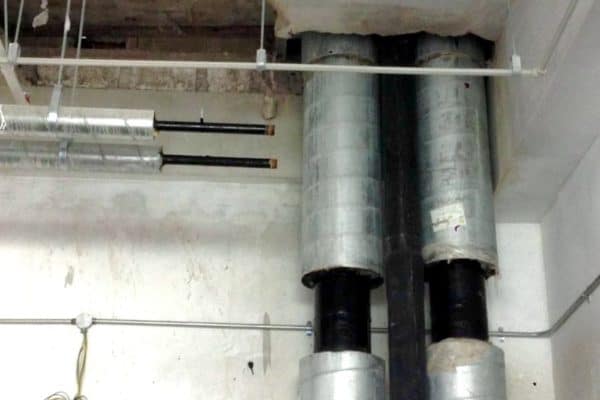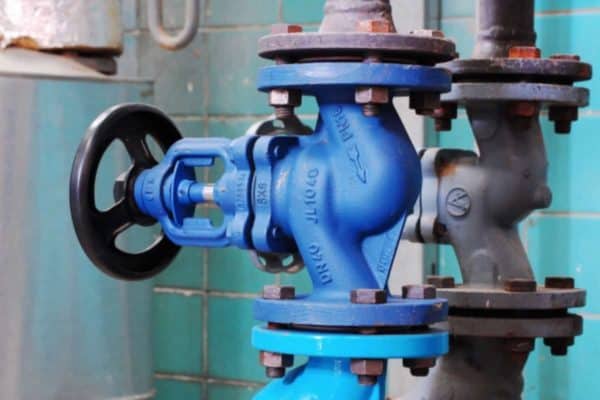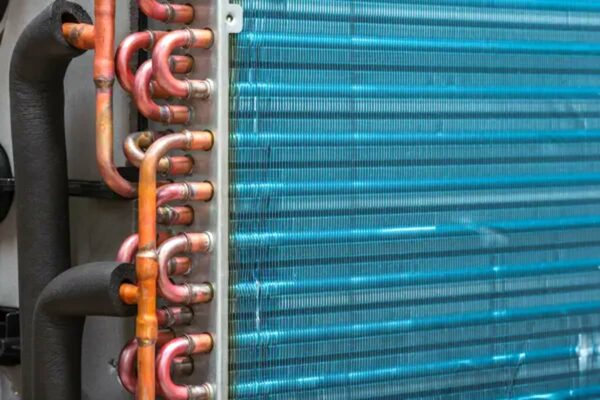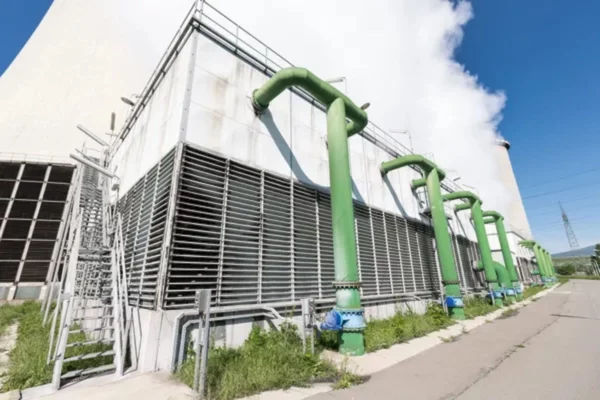Chilled Water Flow Rate Calculation (IP & SI)
When designing a chilled water system, the chilled water flow rate is one of the parameters to calculate. Most of the time, it is estimated through the rule of thumb (gpm per ton). However, it can also be calculated by hand.
To calculate chilled water flow rate, determine the chilled water supply-return design temperature and chiller capacity first. Then, use the heat transfer formula (Q=mcθ) to calculate the required chilled water flow rate. The result is ft3/hr for IP unit and m3/s for SI unit.
For many years, a standard chilled water gpm per ton has been widely practiced. However, modern chilled water systems are switching to a lower gpm per ton to save energy.
Chilled Water GPM per Ton
In a chilled water system, the flow rate “gpm per ton” is referring to how much water flow for every refrigeration tonnage (RT). The gpm stands for gallons per minute and it is based on the Imperial unit.
For SI unit, the flow rate is expressed in cubic meter per second (m3/s). However, litre per second (L/s) is more commonly used by the HVAC industry as it is easier to look at the numbers.
Now, a typical 600 RT chiller may have an evaporator flow rate (chilled water flow rate) of 1439 gpm at full load. If we take the flow rate and divide it by the chiller capacity, we get:
1439 gpm ÷ 600 RT = 2.398 gpm per ton
Therefore, the standard value for chilled water flow rate is about 2.4 gpm per ton.
To get the chiller evaporator flow rate, you normally have to get the chiller selected first. But, if you don’t, how can you calculate the required chilled water flow?
Chilled Water Flow Rate Calculation (IP)
When designing a new chilled water system, the chilled water flow rate has to be determined for pump selection. If the chiller is not yet selected, you can calculate the chilled water flow rate using the heat transfer formula.
Q = mcθ
where,
Q = chiller capacity, btu/hr
m = mass flow rate, lb/hr
c = specific heat of water, 1.0 btu/lb.°F
θ = chilled water temperature difference, °F
Since mass flow rate is the product of fluid density and volumetric flow rate (m=pq), the heat transfer formula can be rearranged as follows:
Q = pqcθ
where,
Q = chiller capacity, btu/hr
p = water density, 62.4 lb/ft3
q = chilled water flow rate, ft3/hr
c = specific heat of water, 1.0 btu/lb.°F
θ = chilled water temperature difference, °F
Before we can calculate the chilled water flow rate, we must determine the chiller capacity and the chilled water supply-return design temperature.
As discussed in my post about high delta T chilled water system, the standard chilled water design temperature is supply 44°F and return 54°F. Assume that the cooling load is 600 RT, the required chilled water flow rate can be calculated as follows:
Q = pqcθ
600 x 12000 = 62.4 x q x 1 x (54-44)
q = 7200000 ÷ 624
q = 11538.46 ft3/hr
Then, convert the chilled water flow rate from ft3/hr to gpm by dividing 11538.46 by 8.021 and we get a chilled water flow rate of 1438.5 gpm or 1439 gpm.
What we know from the calculation is that the standard 2.4 gpm per ton is based on the standard chilled water design temperature of supply 44°F and return 54°F, or anything that results in a delta T (ΔT) of 10°F.
As I touched on it earlier, modern chilled water systems use a greater delta T, resulting in a lower chilled water gpm per ton that saves pump energy.
To convert from IP to SI unit, use my HVAC Online Unit Converter.
Chilled Water Flow Rate Calculation (SI)
When designing a new chilled water system, the chilled water flow rate has to be determined for pump selection. If the chiller is not yet selected, you can calculate the chilled water flow rate using the heat transfer formula.
Q = mcθ
where,
Q = chiller capacity, kW
m = mass flow rate, kg/s
c = specific heat of water, 4.187 kJ/kg.°C
θ = chilled water temperature difference, °C
Since mass flow rate is the product of fluid density and volumetric flow rate (m=pq), the heat transfer formula can be rearranged as follows:
Q = pqcθ
where,
Q = cooling capacity, kW
ρ = water density, 997 kg/m3
q = chilled water flow rate, m3/s
c = specific heat of water, 4.187 kJ/kg.°C
θ = chilled water temperature difference, °C
So, before we can calculate the chilled water flow rate, we must determine the chiller capacity and the chilled water supply-return design temperature.
As discussed in my post about high delta T chilled water system, the standard chilled water design temperature is supply 6.7°C and return 12.2°C. Assume that the cooling load is 2110 kW, the required chilled water flow rate can be calculated as follows:
Q = pqcθ
2110 = 997 x q x 4.187 x (12.2-6.7)
q = 2110 ÷ 22959.41
q = 0.0919 m3/s
Then, convert the chilled water flow rate from m3/s to L/s by multiplying 0.0919 by 1000 and we get a chilled water flow rate of 91.9 L/s or 92 L/s.
What we know from the calculation is that the standard 2.4 gpm per ton is based on the standard chilled water design temperature of supply 44°F (6.7°C) and return 54°F (12.2°C), or anything that results in a delta T of 10°F (5.5°C).
As I touched on it earlier, modern chilled water systems use a greater delta T, resulting in a lower chilled water gpm per ton that saves pump energy.
On a side note, if you want to quickly learn about chilled water system, you can get my Chilled Water System (eBook). If you’re into design, you can enroll in my Chilled Water System Design Course where I teach you various design procedures with tons of examples.
Chilled Water System Design Course
Learn how to design a chilled water system with AHU/FCU selection, chiller sizing, cooling tower sizing, pump sizing, piping design, ductwork design and more.
ASHRAE 90.1 Standard GPM per Ton
The ASHRAE 90.1 standard requires chilled water cooling coils to be designed for at least 15°F delta T (temperature difference between supply and return). The chilled water return temperature must be equal or above 57°F.
If the cooling load of 600 RT is now designed based on a chilled water delta T of 15°F, the required chilled water flow rate becomes 959 gpm. By dividing 959 gpm by 600 RT, we can see that the new standard for chilled water flow rate is 1.6 gpm per ton.
With the new standard, chilled water systems see a much lower chilled water flow rate and this helps reduce the pump power significantly as I explain why in the following.
How Reduced Chilled Water Flow Rate Saves Energy
A chilled water pump will see 2 times power consumption reduction if the chilled water flow rate is reduced by 1 time. This is due to the Affinity Laws.
As mentioned earlier, if the required chilled water flow rate for 600 RT is calculated based on 15°F instead of 10°F, the result is 959 gpm instead of 1439 gpm, a 33% reduction.
Now, the Affinity Laws when applied to a pump state that:
- Q1 / Q2 = N1 / N2
The change in the flow rate (Q) is directly proportional to the change in the pump speed (N). - H1 / H2 = (N1 / N2)2
The change in the pump head (H) is directly proportional to the square of the change in the pump speed (N). - P1 / P2 = (N1 / N2)3
The change in the pump power (P) is directly proportional to the cube of the change in the pump speed (N).
In my post about pump head calculation, we can see from the Hazen-Williams Equation that for the same pipe diameter, a 33% reduction in the chilled water flow rate (1439 gpm to 959 gpm) will result in an approximately 53% reduction in the head loss.
If the initial pump head is 40 m at 1439 gpm, the required pump head becomes 19 m when the flow rate is reduced to 959 gpm.
Given that the pump impeller diameter remain unchanged and the initial pump speed is 1480 RPM, the resulting pump speed can be calculated as follows:
H1 / H2 = (N1 / N2)2
40 / 19 = (1480 / N2)2
N2 = 1020 RPM
Assume that the initial pump power is 36 kW. So, the resulting power after the pump speed reduction can be estimated as follows:
P1 / P2 = (D1 / D2)3
36 / P2 = (1480 / 1020)3
P2 = 11.78 kW
Based on the Affinity Laws, we can see that a mere 33% reduction in the flow rate result in a significant 67% reduction in power consumption (2 times). That’s why the industry is moving toward a reduced chilled water flow design.
Chilled Water Velocity
Speaking of flow, we can’t be not mentioning the velocity. The flow rate of chilled water is depending on several factors including water velocity and pipe size.
The velocity of chilled water is determined based on the application and the acceptable erosion rate. In a chilled water system, the water velocity is generally limited at equal and below 10 ft/s (3 m/s). Depending on which section in the pipe, the velocity may be designed with a different limit.
For example, the recommended water velocity at the pump discharge is 8-12 ft/s and for header pipes, the recommended water velocity is 4-15 ft/s.
Once the flow rate and the water velocity are set, the pipe size can be determined. To learn about chilled water pipe sizing, read my post on how to size chilled water pipes.
For existing systems, when the chilled water flow rate is known, the chiller capacity can be calculated. For that, see my post on chiller capacity calculation.
Next, check out my article Condenser Water Flow Rate Calculation (IP & SI) to complete the flow rate calculation work.
Once again, you can get my Chilled Water System (eBook) to quickly learn more about chilled water system. But, if you want to learn how to design a chilled water system from start to end, I encourage you check out my Chilled Water System Design Course.
Chilled Water System Design Course
Learn how to design a chilled water system with AHU/FCU selection, chiller sizing, cooling tower sizing, pump sizing, piping design, ductwork design and more.
If you have anything to add (or ask) about this topic, leave a comment down below!









